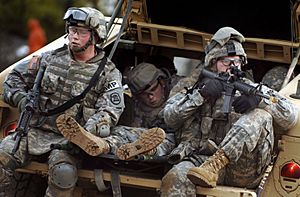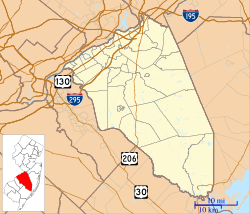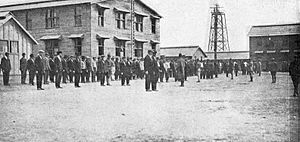Fort Dix facts for kids
Quick facts for kids Fort Dix |
|
|---|---|
| Located near: Trenton, New Jersey | |

U.S. Army combat training at Fort Dix in January 2008
|
|
| Coordinates | 40°01′09″N 74°31′22″W / 40.01917°N 74.52278°W |
| Site history | |
| Built | 1917 |
| In use | 1917–present |
|
Army Support Activity Fort Dix
|
||
|---|---|---|
|
||
| Country | ||
| State | ||
| County | Burlington | |
| Township | New Hanover Pemberton Springfield |
|
| Area | ||
| • Total | 10.34 sq mi (26.78 km2) | |
| • Land | 10.21 sq mi (26.45 km2) | |
| • Water | 0.13 sq mi (0.33 km2) 1.22% | |
| Elevation | 141 ft (43 m) | |
| Population
(2020)
|
||
| • Total | 6,508 | |
| • Density | 637.16/sq mi (246.02/km2) | |
| Time zone | UTC−05:00 (Eastern (EST)) | |
| • Summer (DST) | UTC−04:00 (Eastern (EDT)) | |
| ZIP Code |
08640
|
|
| Area code(s) | 609, 640 | |
| FIPS code | 34-24300 | |
| GNIS feature ID | 02389104 | |
Fort Dix is a well-known United States Army base in New Jersey. It is officially called the Army Support Activity (ASA) at Joint Base McGuire–Dix–Lakehurst. The base is located about 16.1 kilometers (10 miles) southeast of Trenton, New Jersey.
Fort Dix is part of a larger military area. This area is managed by the Air Force's Air Mobility Command. In 2020, the Fort Dix area had a population of 6,508 people.
The base was first created in 1917. In 2009, it joined with nearby Air Force and Navy bases. This created the Joint Base McGuire-Dix-Lakehurst (JB MDL). Even so, many people still call it "Fort Dix." From 2015 to 2016, Colonel Shelley Balderson was the commander. She was the first woman to lead Fort Dix in its long history.
Contents
What is Fort Dix?
Fort Dix is a key part of Joint Base McGuire-Dix-Lakehurst. The United States Air Force helps run the base. The 87th Air Base Wing (87 ABW) manages daily operations. This includes things like utilities, child care, and gyms.
However, the Army and Navy parts of the base keep their own leaders. They also manage their own missions and people. The commanders of Fort Dix and Lakehurst also serve as Deputy Joint Base Commanders.
How Fort Dix Got Its Name
Fort Dix started on July 16, 1917. It was first called Camp Dix. It was named after Major General John Adams Dix. He was a hero from the War of 1812 and the American Civil War. He also served as a U.S. Senator and Governor of New York.
Training Soldiers Through History
Fort Dix has a long history of training soldiers. It helped prepare troops for World War I. It continued this mission until April 2015. In 1978, Fort Dix welcomed the first female recruits for basic training. In 1991, it even trained civilians from Kuwait. This helped them take part in their country's freedom.
Fort Dix stopped its active Army training in 1991. But it still serves as a training site. Now, all parts of the U.S. military use it for training. An Army Colonel leads the base today.
Who is Stationed at Fort Dix?
Many different military groups are based at Fort Dix. They include units from the Army, Air Force, Navy, and Coast Guard. Here are some of the units:
- 1st Brigade, Atlantic Training Division, 84th Training Command
- 99th Readiness Division
- 174th Infantry Brigade
- 305th Aerial Port Squadron
- Fleet Logistics Squadron (VR-64)
- Marine Aircraft Group 49
- Military Entrance Processing Station
- Navy Operational Support Center
- NCO Academy
- United States Air Force Expeditionary Center
- USCG Atlantic Strike Team
Fort Dix's Past
Construction of Fort Dix began in June 1917. It was first known as Camp Dix. It was a place where soldiers trained and got ready for World War I. After the war, it became a place where soldiers returned home.
Between the World Wars, Camp Dix helped the Civilian Conservation Corps. This group helped young men find work during the Great Depression. On March 8, 1939, Camp Dix became Fort Dix. It was now a permanent Army base. During and after World War II, it served the same important roles.
On July 15, 1947, Fort Dix became a basic training center. It was also home to the 9th Infantry Division. Later, during the Vietnam War, the base grew a lot. Soldiers even trained in a special mock Vietnam village. Since then, Fort Dix has sent soldiers to many conflicts. These include the Gulf War, Bosnia, Afghanistan, and Iraq.
U.S. Coast Guard at Fort Dix
The Atlantic Strike Team (AST) of the United States Coast Guard is based at Fort Dix. This team is part of the United States Department of Homeland Security. They respond to oil spills and dangerous material releases. Their job is to protect people's health and the environment.
Federal Prison at Fort Dix
Fort Dix is also home to a large federal prison. It is called the Federal Correctional Institution, Fort Dix. This prison holds male inmates. It is one of the largest federal prisons in America.
Changes to Fort Dix's Mission
In the early 1990s, Fort Dix was almost closed. It had lost its main job of basic training. But supporters worked to keep it open. The Army Reserve became interested in using the base for training.
With new investments, Fort Dix grew again. It now employs about 3,000 people. Up to 15,000 troops train there on weekends. Since the September 11 attacks, it has been a major point for reserve and National Guard troops.
Fort Dix is now a "Power Projection Platform." This means it helps train and support military units. It also supports soldiers, families, and retired military members. In 1998, Fort Dix supported over 1.1 million days of training.
Changes in 2005
In 2005, the U.S. Department of Defense made more changes. Fort Dix became part of the Joint Base McGuire-Dix-Lakehurst. This was the first base of its kind in the United States. It is also the only joint base that includes all three military branches. Fort Dix uses and supports training across 31,000 acres of the joint base.
Safety and Security
Fort Dix has been the target of planned attacks. In 1970, a group planned to set off a bomb at a dance on the base. The plan failed when the bomb exploded early.
In 2007, six people were arrested. They were planning an attack against Fort Dix. They wanted to attack soldiers with automatic weapons. They were charged with planning to harm U.S. soldiers.
Ultimate Weapon Monument
In 1957, two soldiers, Steven Goodman and Stuart Scherr, created a small clay model. It showed a charging infantryman. A public relations officer saw it and thought it was a great idea. They decided to build a larger statue for Fort Dix.
Goodman and Scherr built a 12-foot tall statue. They used old railroad tracks and other materials. It showed a soldier in battle gear, representing all soldiers.
By 1988, the statue needed repairs. People raised over $100,000 to fix it. The statue was recast in bronze. Its concrete base was replaced with black granite.
The statue is now 25 feet tall. It stands at the entrance to Infantry Park. The words on it say:
This monument is dedicated to
the only indispensable instrument of war,
The American Soldier—
The Ultimate Weapon
"If they are not there,
you don't own it."
17 August 1990
Geography and Climate
Fort Dix covers about 26.9 square kilometers (10.389 square miles). Most of this area is land. A small part is water.
The climate in Fort Dix has hot, humid summers. Winters are generally mild to cool. It has a humid subtropical climate.
Population Information
| Historical population | |||
|---|---|---|---|
| Census | Pop. | %± | |
| 1970 | 26,290 | — | |
| 1980 | 14,297 | −45.6% | |
| 1990 | 10,205 | −28.6% | |
| 2000 | 7,464 | −26.9% | |
| 2010 | 7,716 | 3.4% | |
| 2020 | 6,508 | −15.7% | |
| Population sources: 1970–1980 1990-2010 2000 2010 2020 |
|||
In 2010, there were 7,716 people living in the Fort Dix area. About 52.57% were White, and 34.47% were Black or African American. About 21.47% of the population were Hispanic or Latino.
Many households had children under 18. The average household had about three people. The average family had about three to four people. The median age of people living there was 38.9 years old.
Getting Around Fort Dix
New Jersey Route 68 connects Fort Dix to other major roads. These include U.S. Route 206 and Interstate 295. New Jersey Transit provides bus service to and from Philadelphia on the 317 route.
Schools for Fort Dix Families
The U.S. Census Bureau says that "Joint Base McGuire-Dix-Lakehurst" has its own school district. However, the Department of Defense Education Activity does not run schools on the base. Students attend public schools in nearby towns.
Families can choose from a few school districts. These include North Hanover Township School District (for grades PK-6) and Northern Burlington County Regional School District (for grades 7-12). They can also choose Pemberton Township School District (for grades K-12). Fort Dix Elementary School is located on the base and is part of the Pemberton district.
Famous People from Fort Dix
Several notable people have connections to Fort Dix:
- Jay Berger (born 1966), a former professional tennis player.
- Bruce Hill (born 1964), a former wide receiver for the Tampa Bay Buccaneers.
- Jim Riggleman (born 1952), a former professional baseball player and manager.
- Mel Brooks (born 1926), a famous American actor, comedian, and filmmaker.
- Franco Harris (1950-2022), a National Football League Hall of Fame running back, was born in Fort Dix.
Images for kids
See also
 In Spanish: Fort Dix para niños
In Spanish: Fort Dix para niños






